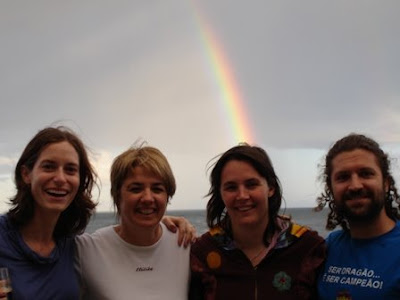
Location: 62° 11' N - 13° 48' W
Temperature: 10°C
Wind: 31.8 Knots - 335°/North
Hello fellow teachers, Thank you for continuing on our journey with us!
Today we are on the second day of a 5 days transit up north. Right now we are somewhere between Iceland and the Faeroe Islands. The next site we are going to core are the Voeringer Plateau. Until now we have taken 8 Calypso cores, 6 Casqs and only one Multicore, some failed unfortunately.
In order for an oceanographic campaign to be successful many people must collaborate on many levels. Research of this type requires a tremendous amount of planning and manpower. For instance, the AMOCINT project is spearheaded by four groups. Each group focuses on one or more specific geographic areas, but for the most part they conduct similar and/or complementary analyses on the sediments. The group from the University of Kiel is currently focusing on the vicinity of the Açores, The two French groups from the University of Bordeaux and the L.S.C.E. of Gif-sur-Yvette are focusing on the areas of the Charlie-Gibbs Fracture Zone, Gardar strait and the Vöringer plateau.
The Bjerknes Center of Climate from Norway is covering the sites outside West Africa, the Faeroe Islands and also the Vöringer plateau.
Although the group from Portugal (from the INETI (Instituto Nacional de Engenharia, Tecnologia e Inovação) Departamento de Geologia Marinha) is not present on this leg of the cruise, they will take cores around the Portuguese margin on a cruise starting in July. Each group is involved in decisions affecting the mission, however, it should also be noted that the overall goal of the campaign is the same.
We all also must collaborate on smaller levels as well. For instance, we are all organized into watches, or shifts. Gertrud, Hélder, and Catalina are on the 4-8 shift, afternoon and evening, and Angela and Jean have the 8-12 shifts, morning and evening. In order to process the samples properly in the time allotted everyone must do their part and be present for their shift. Our shift groups were organized to allow people from diverse background to work together and get to know each other. Each shift group includes people from different institutions, professions, nationalities, and with different cultural norms, work styles, and languages. This is an example of why it is important for our students to work well together in groups despite differences they might have.
The research effort also involves many people with backgrounds and skill sets other than oceanography. There are many aspects that go into designing and operating coring equipment and a research vessel, as well as planning an oceanographic mission. The crew is largely from France and Madagascar, and is also very diverse, and made-up of men and women from many different ages and backgrounds.
Although what we do on a day-to-day basis before, during, and after the cruise is very different, we are all working towards a common goal. There are many people on the ship from different cultural backgrounds and who speak different languages. Just some of the languages you will hear on a daily basis during this campaign are French, English, Norwegian, and German, but there are many others!
This provides a fantastic learning opportunity. When we discuss the collaborative nature of science with our students, an oceanographic campaign provides a great example!
Thank you again for your continued interest!
Sincerely,
Hélder-Catalina-Gertrud-Jean-Angela-Carlo
 No âmbito do Workshop Geoscience Information for Teachers (GIFT) apresentámos ainda um póster sobre o mesmo tema.
No âmbito do Workshop Geoscience Information for Teachers (GIFT) apresentámos ainda um póster sobre o mesmo tema.





















































